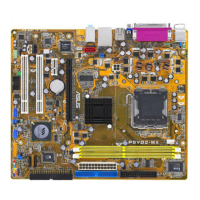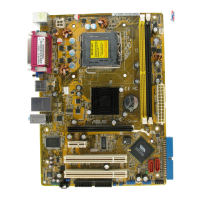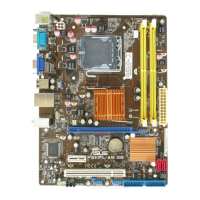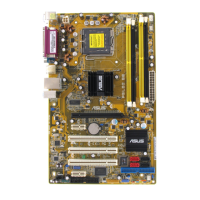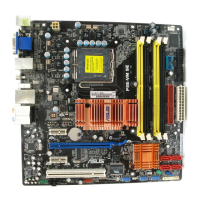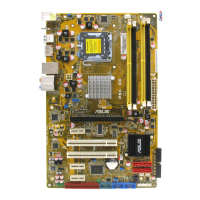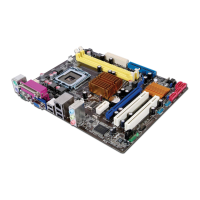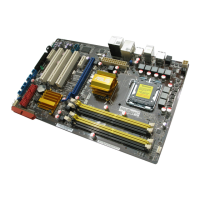Do you have a question about the Asus P5VD2-MX SE and is the answer not in the manual?
Guidelines to prevent electrical shock hazards during system operation and handling.
Precautions for safe installation, handling, and environment for motherboard use.
Details on supported CPU types and the motherboard's chipset.
Information on DDR2 memory support and available expansion slot types.
Overview of rear and internal connectors, including USB, LAN, and audio.
Summary of BIOS features and ASUS-specific functionalities.
Introduction to the motherboard and a list of included package items.
Key features of the motherboard, including Intel processor support.
Details on ASUS-specific technologies like EZ Flash and CrashFree BIOS.
Essential safety and preparation steps before installing components.
Overview of the motherboard's physical layout and component identification.
Detailed steps for installing the CPU onto the LGA775 socket.
Instructions for installing the CPU heatsink and fan assembly.
Procedures for installing DDR2 memory modules into DIMM sockets.
Steps for installing expansion cards into PCI and PCIe slots.
Explanation of jumper settings and rear/internal motherboard connector functions.
Methods for managing and updating the motherboard's BIOS using AFUDOS and EZ Flash.
Guide to navigating the BIOS setup utility interface and understanding its components.
Configuration of basic system settings like time, date, and IDE devices.
Detailed settings for CPU, chipset, USB, onboard devices, and PCI/PnP.
Configuration options for system power states, ACPI, and hardware monitoring.
Settings for boot device priority, boot options, and BIOS security.
Procedures for saving or discarding BIOS changes and exiting setup.
Recommendations for installing operating systems to maximize hardware features.
Overview of drivers, utilities, and applications available on the support CD.
Instructions for installing essential device drivers from the support CD.
Guide to installing motherboard utilities like ASUS PC Probe II and Update.
Steps to create a RAID driver disk for storage controller setup.
How to access supplementary user manuals and find ASUS contact information.
Guidelines to prevent electrical shock hazards during system operation and handling.
Precautions for safe installation, handling, and environment for motherboard use.
Details on supported CPU types and the motherboard's chipset.
Information on DDR2 memory support and available expansion slot types.
Overview of rear and internal connectors, including USB, LAN, and audio.
Summary of BIOS features and ASUS-specific functionalities.
Introduction to the motherboard and a list of included package items.
Key features of the motherboard, including Intel processor support.
Details on ASUS-specific technologies like EZ Flash and CrashFree BIOS.
Essential safety and preparation steps before installing components.
Overview of the motherboard's physical layout and component identification.
Detailed steps for installing the CPU onto the LGA775 socket.
Instructions for installing the CPU heatsink and fan assembly.
Procedures for installing DDR2 memory modules into DIMM sockets.
Steps for installing expansion cards into PCI and PCIe slots.
Explanation of jumper settings and rear/internal motherboard connector functions.
Methods for managing and updating the motherboard's BIOS using AFUDOS and EZ Flash.
Guide to navigating the BIOS setup utility interface and understanding its components.
Configuration of basic system settings like time, date, and IDE devices.
Detailed settings for CPU, chipset, USB, onboard devices, and PCI/PnP.
Configuration options for system power states, ACPI, and hardware monitoring.
Settings for boot device priority, boot options, and BIOS security.
Procedures for saving or discarding BIOS changes and exiting setup.
Recommendations for installing operating systems to maximize hardware features.
Overview of drivers, utilities, and applications available on the support CD.
Instructions for installing essential device drivers from the support CD.
Guide to installing motherboard utilities like ASUS PC Probe II and Update.
Steps to create a RAID driver disk for storage controller setup.
How to access supplementary user manuals and find ASUS contact information.
| Non-ECC | Yes |
|---|---|
| Number of memory slots | 2 |
| Maximum internal memory | 2 GB |
| Processor socket | LGA 775 (Socket T) |
| Processor manufacturer | Intel |
| Processor system buses supported | 1066 MHz |
| USB 2.0 connectors | 4 |
| S/PDIF out connector | No |
| USB 2.0 ports quantity | USB 2.0 ports have a data transmission speed of 480 Mbps, and are backwards compatible with USB 1.1 ports. You can connect all kinds of peripheral devices to them. |
| Parallel ports quantity | 1 |
| Audio chip | Realtek ALC660 |
| Motherboard form factor | ATX |
| Bundled software | ASUS Screen Saver Anti-virus ASUS PC Probe II ASUS Update VCT |
| BIOS memory size | 16 Mbit |
